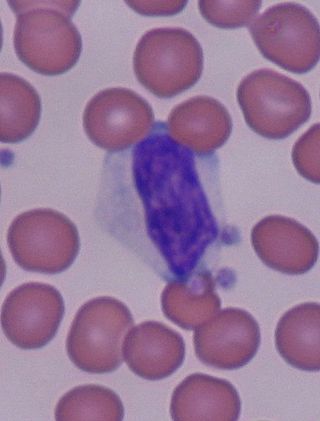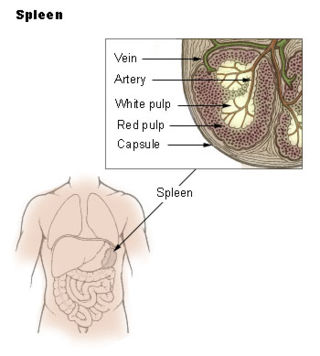Related Research Articles

A lymphocyte is a type of white blood cell (leukocyte) in the immune system of most vertebrates. Lymphocytes include T cells, B cells, and innate lymphoid cells, of which natural killer cells are an important subtype. They are the main type of cell found in lymph, which prompted the name "lymphocyte". Lymphocytes make up between 18% and 42% of circulating white blood cells.
Anergy, within the realm of immunology, characterizes the absence of a response from the body's defense mechanisms when confronted with foreign substances. This phenomenon involves the direct induction of peripheral lymphocyte tolerance. When an individual is in a state of anergy, it signifies that their immune system is incapable of mounting a typical response against a specific antigen, typically a self-antigen. The term anergy specifically refers to lymphocytes that exhibit an inability to react to their designated antigen. Notably, anergy constitutes one of the essential processes fostering tolerance within the immune system, alongside clonal deletion and immunoregulation. These processes collectively act to modify the immune response, preventing the inadvertent self-destruction that could result from an overactive immune system.

A lymphoblast is a modified naive lymphocyte with altered cell morphology. It occurs when the lymphocyte is activated by an antigen and increased in volume by nucleus and cytoplasm growth as well as new mRNA and protein synthesis. The lymphoblast then starts dividing two to four times every 24 hours for three to five days, with a single lymphoblast making approximately 1000 clones of its original naive lymphocyte, with each clone sharing the originally unique antigen specificity. Finally the dividing cells differentiate into effector cells, known as plasma cells, cytotoxic T cells, and helper T cells.

In immunology, reactive lymphocytes, variant lymphocytes, atypical lymphocytes, Downey cells or Türk cells are cytotoxic (CD8+) lymphocytes that become large as a result of antigen stimulation. Typically, they can be more than 30 μm in diameter with varying size and shape.
A peripheral blood mononuclear cell (PBMC) is any peripheral blood cell having a round nucleus. These cells consist of lymphocytes and monocytes, whereas erythrocytes and platelets have no nuclei, and granulocytes have multi-lobed nuclei. In humans, lymphocytes make up the majority of the PBMC population, followed by monocytes, and only a small percentage of dendritic cells.

The marginal zone is the region at the interface between the non-lymphoid red pulp and the lymphoid white-pulp of the spleen.
Splenic marginal zone lymphoma (SMZL) is a type of marginal zone lymphoma, a cancer made up of B-cells that replace the normal architecture of the white pulp of the spleen. The neoplastic cells are both small lymphocytes and larger, transformed lymphoblasts, and they invade the mantle zone of splenic follicles and erode the marginal zone, ultimately invading the red pulp of the spleen. Frequently, the bone marrow and splenic hilar lymph nodes are involved along with the peripheral blood. The neoplastic cells circulating in the peripheral blood are termed villous lymphocytes due to their characteristic appearance.
Autoimmune lymphoproliferative syndrome (ALPS) is a form of lymphoproliferative disorder (LPDs). It affects lymphocyte apoptosis.

Chemokineligand 13 (CXCL13), also known as B lymphocyte chemoattractant (BLC) or B cell-attracting chemokine 1 (BCA-1), is a protein ligand that in humans is encoded by the CXCL13 gene.
Lymphocyte homing receptors are cell adhesion molecules expressed on lymphocyte cell membranes that recognize addressins on target tissues. Lymphocyte homing refers to adhesion of the circulating lymphocytes in blood to specialized endothelial cells within lymphoid organs. These diverse tissue-specific adhesion molecules on lymphocytes and on endothelial cells contribute to the development of specialized immune responses.

T-cell-prolymphocytic leukemia (T-PLL) is a mature T-cell leukemia with aggressive behavior and predilection for blood, bone marrow, lymph nodes, liver, spleen, and skin involvement. T-PLL is a very rare leukemia, primarily affecting adults over the age of 30. It represents 2% of all small lymphocytic leukemias in adults. Other names include T-cell chronic lymphocytic leukemia, "knobby" type of T-cell leukemia, and T-prolymphocytic leukemia/T-cell lymphocytic leukemia.
Large granular lymphocytic (LGL) leukemia is a chronic lymphoproliferative disorder that exhibits an unexplained, chronic elevation in large granular lymphocytes (LGLs) in the peripheral blood.

Aggressive NK-cell leukemia is a disease with an aggressive, systemic proliferation of natural killer cells and a rapidly declining clinical course.

B-cell prolymphocytic leukemia, referred to as B-PLL, is a rare blood cancer. It is a more aggressive, but still treatable, form of leukemia.

G protein-coupled receptor 15 is a protein that in humans is encoded by the GPR15 gene.

CD160 antigen is a protein that in humans is encoded by the CD160 gene.
Splenic lymphoma with villous lymphocytes is a rare type of lymphoma that involves mature B cells. Older names include lymphoma simulating hairy cell leukemia and lymphoplasmacytic lymphoma with circulating villous lymphocytes. The characteristic villous lymphocytes will appear in a blood smear of the peripheral blood of patients with this type of lymphoma. These lymphocytes will have an oval nucleus with the “cobblestone” pattern of nuclear chromatin typical of more mature lymphoid cells. The cytoplasmic projections, or villi, are found in a polar distribution. Whether this condition is identical to splenic marginal zone lymphoma, or only highly similar, is a matter of debate.

White blood cells, also called immune cells or immunocytes, are cells of the immune system that are involved in protecting the body against both infectious disease and foreign invaders. White blood cells include three main subtypes: granulocytes, lymphocytes and monocytes.
Lymph node stromal cells are essential to the structure and function of the lymph node whose functions include: creating an internal tissue scaffold for the support of hematopoietic cells; the release of small molecule chemical messengers that facilitate interactions between hematopoietic cells; the facilitation of the migration of hematopoietic cells; the presentation of antigens to immune cells at the initiation of the adaptive immune system; and the homeostasis of lymphocyte numbers. Stromal cells originate from multipotent mesenchymal stem cells.
Mixed lymphocyte reaction (MLR) is a test used by pharmaceutical and biotech organizations to show the safety of a drug or implantable material. It is commonly used as part of the FDA clearance process. Put simply, it is mixing populations of T-lymphocytes together, and measuring the reaction that occurs. Technically, it is an ex-vivo cellular immune assay that occurs between two allogeneic lymphocyte populations. In a one-way MLR, only one lymphocyte population can respond or proliferate. In a two-way MLR, both populations can proliferate. MLR’s are performed to assess how T-cells react to external stimuli. T cells are a type of white blood cell that scans for cellular abnormalities and infections. They are essential to human immunity.
References
- ↑ Chiu, PL., Chang, CH., Lin, YL.; et al. (2019). "Rapid and Safe Isolation of Human Peripheral Blood B and T Lymphocytes through Spiral Microfluidic Channels". Sci Rep. 9: 8145. doi:10.1038/s41598-019-44677-3. PMC 6544655 .
{{cite journal}}: CS1 maint: multiple names: authors list (link)